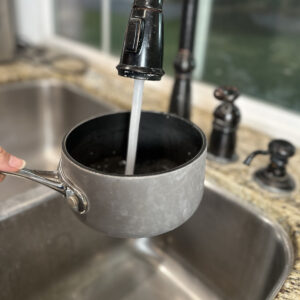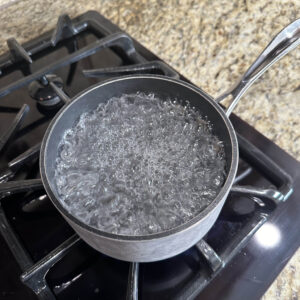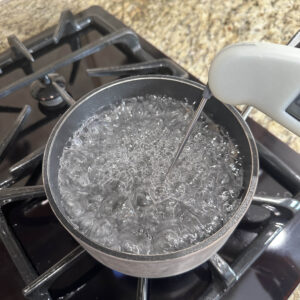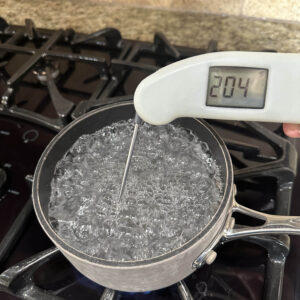Baking Using a Food Thermometer
Baking using a food thermometer can make your life so much simpler. My mom used to make Pecan Logs around Christmas time. I remember being a young girl hearing her talk about how difficult the fondant was and would hear her say things like, I just don’t know if it will turn out this time, and you know what… there were times it wouldn’t turn out at all and there were times where she would get this creamy fondant that was phenomenal.
It wasn’t until I was older and on my own quest of learning how to bake consistently that I thought… there has to be a better way.
And lo and behold, there was.
I decided to try using a food thermometer and after a little trial and error (working to get the temperature just right) time after time I would consistently get beautiful fondant. This was when I really was sold on the food thermometer thing. I discovered how precise temperature can help me in with consistency in my bakery products.
Have you ever had this same problem? Have you ever had your caramel turn into a rock or your custard fail to set properly? Or, have you ever wondered if your pie is ready to take out of the oven? The secret to perfect consistent results lies in mastering the food thermometer, well besides using a food scale of course.
But there is a catch.
Did you know that the temperature of boiling water on the beaches of California is different than in the rocky mountains in Utah? Crazy… I know!
This is because the boiling point of water changes depending on the altitude. The boiling point of water at sea level is 212 degrees Fahrenheit. But that changes depending on altitude and when you have a recipe that deals in drastic changes with minute changes in single degrees, this can mean disaster if you don’t know how to read the temperature correctly.
So, before we jump into how you use and take a temperature with a food thermometer, let’s talk about how to adjust for altitude in some of the things you may encounter while baking. You do a boiling water test.
The Boiling water test
A boiling water test helps you adjust your food thermometer for accuracy at different altitudes. At sea level, water boils at 212°F (100°C), but at higher altitudes, the boiling point decreases due to lower atmospheric pressure. For every 500 feet of elevation, the boiling point drops by about 1°F. By boiling water and checking the thermometer reading, you can identify how far off it is from the local boiling point. This helps you adjust your thermometer’s accuracy for baking, candy making, or any other temperature-sensitive cooking at high altitudes.
Step 1: Gather Your Tools
- Food thermometer
- Pot of water
- Stove
Step 2: Put water in a small saucepan. Fill with enough water that you will be able to put a thermometer in and test the water temperature without touching the bottom of the pan.

Step 3: Turn on the heat and bring the water to a rolling boil.

Step 4: Insert the food thermometer into the boiling water, making sure it doesn’t touch the sides or bottom of the pot.

When the water starts to boil, put the thermometer in the water and wait for the correct readout. Meaning, it may take a minute for your thermometer to catch up to the temperature of the water. Some thermometers are faster than others but I like using a digital thermometer. This thermapen thermometer is my favorite because I can use it on everything from meat to candies to jams etc. It has a fast readout so you don’t overcook your product. It has the fastest readout I have found.
Step 5: Read the temperature on the thermometer.

Take note of the temperature of the water. Here in Utah where my elevation is approximately 4,500 ft above sea level. The water boils at 204 degrees. So that is 8 degrees less than the standard boiling point of water at 212 degrees.
- Tip: Water boils at 212°F at sea level. If you’re at a higher altitude, it will boil at a lower temperature. For example, in Utah, it might boil around 204°F depending on the altitude and barometric pressure. (Don’t let that scare you away… its easier than you think to figure it out)
Adjusting temperature based on altitude
If your water boils at a lower temperature, it means you need to adjust the temperature readings in your recipes.
So here is an example of a calculation:
If your water boils at 202°F in Utah, and a recipe calls for 250°F, you’ll actually need to set your thermometer to (250°F – (212°F – 202°F)) = 340°F. Make sense?
You only need to adjust for temperature based on altitude for things like candy, caramels, syrups, jams etc. Doneness temperatures for baked goods, such as bread, quick breads, and cakes, are determined by changes in protein and starch structures,, which are independent of elevation.
How to take an accurate reading with a food thermometer
You can use a food thermometer to test doneness in meat, breads, candy, treats and more. There are a couple rules to follow to make sure you get an accurate reading. Let’s go over some helpful hints to follow.
To take an accurate reading with a food thermometer, follow these steps:
- Insert the probe into the thickest part of the food, avoiding bones, fat, or the pan, as these can give inaccurate readings.
- For solid foods like meats or bread, ensure the thermometer is placed in the center, where it takes the longest to cook.
- For liquids or candy, submerge the probe at least 2 inches into the liquid without touching the sides or bottom of the pan.
- Wait for the reading to stabilize, which may take a few seconds depending on your thermometer type.
- Check multiple spots in larger foods to ensure the entire item has reached the desired temperature.
Using these steps ensures your thermometer provides an accurate measurement, crucial for food safety and/or perfect results.
Some Common Mistakes or Pitfalls
Your thermometer isn’t calibrated correctly. Click here for a step by step guide for how to calibrate a food thermometer.
When I am taking a reading in candy, jam or anything of that nature, I take the reading after stirring the product and then reading it from different areas in the pan. This helps ensure I am not just getting one hot or cool spot.
Want to try this in action?
Here are a few recipes to try that you will master now that you know how to use a food thermometer.
So here is your challenge. Go and test the boiling point of water and share it with me! I promise this will change the outcome of so many recipes.






